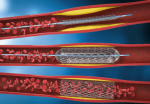Original title: Patient radiation exposure during percutaneous endovascular revascularization of the lower extremity. Reference: Einat Segal et al. Journal of Vascular Surgery. Article in press. Percutaneous endovascular revascularization is emerging as the first line treatment for peripheral artery disease for both intermittent claudication and chronic critical limb ischemia. Radiation doses for these interventions, usually prolonged, have not been<a href="https://solaci.org/en/2013/08/12/high-doses-of-radiation-also-in-peripheral-procedures/" title="Read more" >...</a>
Radiation-associated Lens Opacities in Catheterization Personnel: Results of a Survey and Direct Assessments
The development of interventional cardiology has led us to successfully treat injuries and angiographic situations increasingly complex. This goes along that often the length of procedures is increasing automatically leading to increased fluoroscopy time and film images. The result, often unnoticed, is the possibility of the appearance of irradiation injuries in our patients or in<a href="https://solaci.org/en/2013/02/04/radiation-associated-lens-opacities-in-catheterization-personnel-results-of-a-survey-and-direct-assessments/" title="Read more" >...</a>
Recommendations on occupational radiation protection in interventional cardiology
The evolution in experience of the operators together with the continuous improvement of devices have allowed new procedures that we did not perform a few years ago and that we never imagined possible, not even for the most enthusiastic of interventional cardiologists. Not a huge intellectual effort is required to say that the future<a href="https://solaci.org/en/2013/01/06/recommendations-on-occupational-radiation-protection-in-interventional-cardiology/" title="Read more" >...</a>
Use of Intravascular Lithotripsy vs. Rotational Atherectomy for Severely Calcified Coronary Lesions
Severely calcified coronary stenosis poses a significant challenge for coronary angioplasty procedures. Modifying plaque before stenting is crucial to a successful intervention, since it will prevent the sub expansion associated to worse clinical outcomes at followup. The tools employed to assess complex lesions include specialized balloons such as cutting, scoring, or high pressure balloons, as<a href="https://solaci.org/en/2024/01/22/use-of-intravascular-lithotripsy-vs-rotational-atherectomy-for-severely-calcified-coronary-lesions/" title="Read more" >...</a>
Is Coronary Lithotripsy as Effective as Rotational Atherectomy?
Severely calcified lesions currently pose a significant challenge, as they require adequate preparation through non-compliant balloons or cutting balloons to achieve effective stent expansion. Another option is the use of orbital or rotational atherectomy (RA), but this carries the risk of complications such as slow/no reflow, perforations, dissections, peri-procedural infarction, or guidewire rupture. Despite the<a href="https://solaci.org/en/2023/11/23/is-coronary-lithotripsy-as-effective-as-rotational-atherectomy/" title="Read more" >...</a>
ROTA.shock Outcomes: Intravascular Lithotripsy vs. Rotational Atherectomy
At present, severe calcified coronary stenosis poses a significant challenge for PCI. A successful intervention will require plaque modification prior stenting, seeing as sub-expansion has been associated with worse clinical outcomes at followup. The tools normally used to treat these complex lesions include specialized balloons such as cutting, scoring, and high pressure balloons, as well<a href="https://solaci.org/en/2023/09/08/rota-shock-outcomes-intravascular-lithotripsy-vs-rotational-atherectomy/" title="Read more" >...</a>
Relationship between Distal Vessel Quality and Outcomes in the Treatment of Chronic Total Occlusions
Percutaneous treatment of chronic total occlusions has increase, and has become a a more habitual therapeutic challenge. However, there is limited information on distal vessel quality and its association with outcomes and techniques. This variable appears to be excluded form CTO scores, except for the RECHARGE (REgistry of CrossBoss and Hybrid procedures in FrAnce, the<a href="https://solaci.org/en/2023/07/06/relationship-between-distal-vessel-quality-and-outcomes-in-the-treatment-of-chronic-total-occlusions/" title="Read more" >...</a>
Frequency and Causes of Mortality in Chronic Total Occlusion
In recent years, there has been an increase in the number of percutaneous coronary interventions (PCI) performed to treat chronic total occlusion (CTO). This increase is due to the availability of more advanced technology and greater experience of both operators and specialized centers. However, it is important to note that this technique is not free<a href="https://solaci.org/en/2023/06/14/frequency-and-causes-of-mortality-in-chronic-total-occlusion/" title="Read more" >...</a>
Provisional Stenting vs. Culotte: 5-Year Results of EBC TWO
The optimal treatment of true bifurcation lesions not affecting the left main coronary artery is widely debated. Results from randomized studies have shown neutral or worse outcomes with the two-stent technique. Regarding these studies, researchers used first-generation stents and the secondary branches were small. The EBC TWO study compared the provisional stenting strategy against the<a href="https://solaci.org/en/2023/05/29/provisional-stenting-vs-culotte-5-year-results-of-ebc-two/" title="Read more" >...</a>
AQCA Study: Pre-PCI Virtual QFR for Planning PCI vs. Conventional Angiography
Several studies have used physiological assessment after a percutaneous coronary intervention (PCI) to improve clinical outcomes. However, results are not entirely conclusive. The limitations of using these physiological assessment methods are the need for extra measurements with increased procedure time, more radiation, and more contrast, which in turn leads to higher costs. To counteract these<a href="https://solaci.org/en/2023/04/05/aqca-study-pre-pci-virtual-qfr-for-planning-pci-vs-conventional-angiography/" title="Read more" >...</a>









